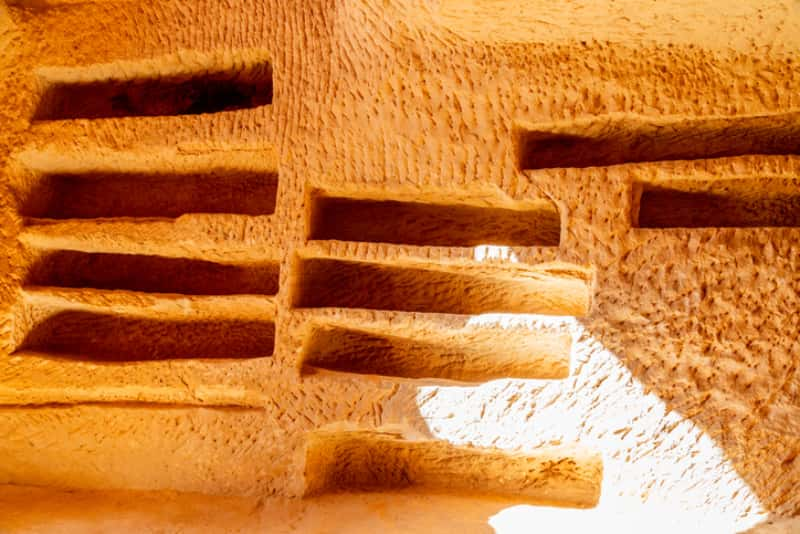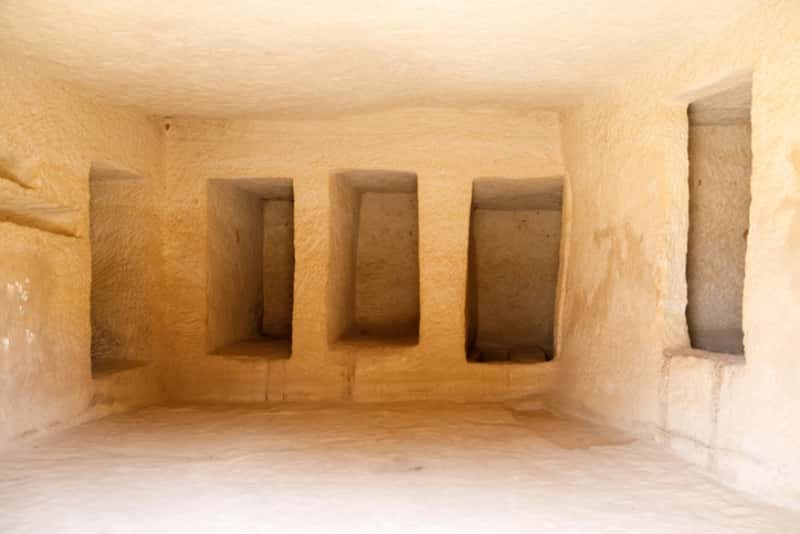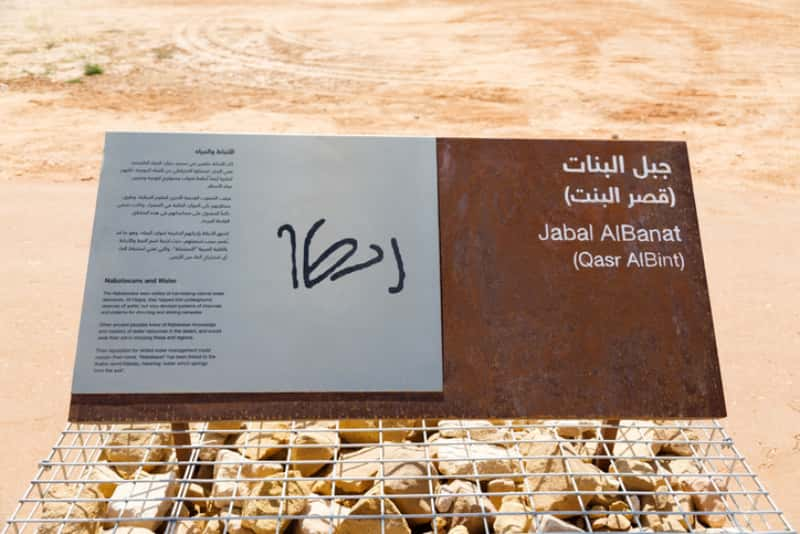Proudly rising from the desert landscape stands Jabal Al-Banat, the "Mountain of the Daughters"—an archeological masterpiece that ranks among Arabia's most extraordinary ancient treasures. This remarkable UNESCO World Heritage site harbors 29 exquisitely carved Nabataean tombs dating back to the 4th century BCE. Each tomb carries its own distinct narrative, silently preserving the legacy of the brilliant civilization that fashioned them.
Visitors to Jabal Al-Banat will find these magnificent structures nestled within Hegra's expansive archeological landscape, where they form part of a grander collection of 111 meticulously hand-carved monuments. The tombs here possess a remarkable quality not found elsewhere—they remain in superior condition compared to their counterparts in the more celebrated Petra. This exceptional preservation allows scholars and travelers alike to extract richer, more nuanced understandings of Nabataean rituals and cultural beliefs.
Perhaps most fascinating about this sandstone sanctuary is the significant female presence etched into its history. Many tombs throughout Jabal Al-Banat were directly commissioned or owned by women, a striking testament to the surprisingly progressive social hierarchy that flourished within Nabataean society. The architectural characteristics visible across these monuments reveal a sophisticated cultural exchange, displaying clear influences borrowed from Greek, Roman, Egyptian, and Persian design traditions. These elements vividly illustrate how the Nabataeans—masters of vital trade routes—formed meaningful connections with neighboring civilizations, absorbing and adapting elements from each into their own distinctive artistic expression.
The Nabataean civilization rose to prominence as one of the ancient world's most influential powers, crafting architectural wonders that continue to captivate modern observers. Among these spectacular creations, Jabal Al-Banat stands majestically within the sandstone landscape of AlUla, Saudi Arabia.
abal Al-Banat's story begins with the Nabataean Kingdom's ascendance from the 4th century BCE through the 2nd century CE. These once-nomadic Arab tribes gradually transformed themselves into settled communities, securing mastery over vital trade pathways linking the Arabian Peninsula to Mediterranean civilizations. Their migration patterns show a calculated movement from the Levant region (now Jordan) into northwestern Arabia during the 1st century BCE, steadily extending their domain southward.
Hegra, home to Jabal Al-Banat, functioned as the Nabataeans' principal southern urban center, while Petra remained their governmental seat. During seven centuries of dominance, Nabataean rulers developed Hegra into a bustling commercial hub, essentially establishing it as the mercantile capital of their realm. The strategic advantage of controlling incense trade routes generated immense wealth and regional influence, wealth they subsequently channeled into their elaborate architectural projects.
The tombs scattered throughout Jabal Al-Banat transcend simple burial functions, offering remarkable windows into Nabataean societal organization and spiritual practices. Meticulously carved decorations and written inscriptions adorning tomb entrances yield valuable insights about their belief systems, customary practices, and the paramount importance of family heritage within their community.
Numerous tombs display foreboding inscriptions that promise divine retribution against trespassers, would-be occupants, or those who might disturb tomb contents. These stern warnings underscore the tombs' sacred character. Social stratification becomes visible through the varying degrees of ornamentation and size differences among tombs—more elaborate structures belonged unmistakably to individuals of greater wealth and status.
Archaeological excavations at Jabal Al-Banat have unearthed textiles, leather artifacts, and human remains, providing scholars with tangible evidence of daily Nabataean existence. The architectural features display unmistakable borrowings from Greek, Roman, Egyptian, and Persian design traditions, reflecting the Nabataeans' cultural absorption from societies they encountered through trade relationships.
The distinctive name "Mountain of the Daughters" stems from the unusual concentration of tombs commissioned or constructed for female occupants. This peculiar characteristic reveals something truly extraordinary about Nabataean society—women wielded significant economic authority and social standing.
Archaeological evidence supports this conclusion, particularly findings at nearby Jabal Ahmar (Red Mountain). Here, researchers uncovered the tomb of an affluent woman named Hinat who commanded resources sufficient not only for her resting place but for 80 additional tombs intended for her descendants. Such discoveries challenge conventional assumptions about gender roles in ancient civilizations, suggesting Nabataean women enjoyed remarkable autonomy and influence.
Local folklore offers alternative explanations for the site's name, ranging from tales of legendary heroines to dramatic narratives describing young women who leaped from the mountain's heights rather than submit to forced marriages. Yet archaeological findings consistently point toward the site's association with influential Nabataean women who possessed both the means and authority to commission these enduring monuments.

The sandstone facades of Jabal Al-Banat immediately arrest the visitor's gaze, their intricate details and exceptional state of preservation telling silent tales across millennia. This magnificent monolithic cluster represents one of Hegra's largest tomb groupings, where 29 meticulously carved chambers showcase the architectural brilliance achieved by Nabataean master craftsmen.
Each tomb throughout Jabal Al-Banat Hegra presents its own architectural personality, though unified by common Nabataean aesthetic principles. The façades boast elaborate decorative features—columns crowned with ornate capitals, stately triangular pediments framing doorways, and distinctive crown-like structures adorning the uppermost sections. These crowns, typically fashioned as two sets of five ascending stairs, carry profound symbolic significance, representing the soul's celestial journey toward the heavens.
Horizontal entablatures stretch across many tomb façades, creating visual harmony and structural definition. Delicate friezes adorned with celestial star patterns or botanical motifs further enrich these stone canvases, adding layers of cultural meaning and artistic sophistication. What renders Jabal Al-Banat AlUla particularly remarkable is how each tomb's architectural complexity directly corresponds to the social standing of its occupants—the stone itself becoming a permanent testament to their earthly status.
The region's plentiful sandstone provided Nabataean artisans with an ideal medium, its naturally warm hues and relatively soft texture allowing for remarkable detail while creating structures that seamlessly complement their desert surroundings.
Particularly revealing aspects of Nabataean craftsmanship become visible in several unfinished tombs, where the distinctive top-down carving methodology remains frozen in time. Sharp-eyed visitors notice how precision and detailing gradually decrease toward the lower portions of certain façades. This specialized carving approach represents a hallmark of Nabataean construction methodology throughout their territorial holdings.
The stone surfaces throughout Jabal Al-Banat, Saudi Arabia, teem with symbolic imagery, carrying profound meanings likely understood immediately by contemporary viewers. Numerous motifs represent the cycle of existence—birth, life, death, rebirth—reflecting sophisticated Nabataean spiritual cosmology.
Though outwardly less elaborate than their counterparts in Petra, these tombs incorporate protective emblems borrowed from neighboring cultures with whom the Nabataeans maintained trade relations:
The tombs of Jabal Al-Banat thus reveal something extraordinary—how the Nabataeans absorbed influences from Greek, Roman, Egyptian, and Persian visual vocabularies while creating a distinctly Nabataean artistic identity. These enduring monuments continue narrating their cultural story across the centuries, standing as silent witnesses to a remarkable civilization's artistic and spiritual achievements.

Layer by layer, the desert sands of Jabal Al-Banat have surrendered their ancient secrets to patient archeological teams. These excavations reveal treasures preserved for millennia, fundamentally reshaping our understanding of Nabataean society and their sophisticated cultural practices.
The scholarly exploration of Jabal Al-Banat began properly in the early 20th century. Dominican fathers Antonin Jaussen and Raphaël Savignac meticulously documented numerous tombs and inscriptions, establishing the first formal records of this remarkable site. Their pioneering work laid the foundations for future research, though deeper insights remained buried beneath centuries of sand.
True revelations emerged during the 2002-2005 joint Franco-Saudi archeological mission. This collaborative effort unearthed substantial evidence illuminating Nabataean funerary customs and social structures in unprecedented detail. Archaeologists uncovered telling evidence at nearby Jabal Ahmar—the tomb of Hinat, a woman of extraordinary wealth who commissioned burial chambers not merely for herself but for 80 descendants. This discovery dramatically challenged conventional wisdom regarding gender roles in ancient societies.
Recognition of these extraordinary findings culminated in 2008 when Hegra received designation as Saudi Arabia's first UNESCO World Heritage site, formally acknowledging its profound cultural significance.
The scholarly value of Jabal Al-Banat stretches well beyond its architectural marvels. The site's remarkable preservation conditions yielded textiles and leather goods alongside human remains, providing tangible glimpses into everyday Nabataean existence. Particularly fascinating discoveries include:
These artifacts, safeguarded by the arid desert climate, create direct connections to individuals who lived two millennia ago. Each item demonstrates the Nabataeans' remarkable ability to establish a sophisticated culture amid harsh environmental conditions.
Present-day conservation at Jabal Al-Banat blends traditional preservation techniques with cutting-edge technologies. The Royal Commission for AlUla (RCU) oversees continuing excavation, development, and restoration initiatives designed to safeguard these irreplaceable cultural treasures.
Among the most innovative conservation approaches is creating digital twins—exquisitely detailed virtual replicas documenting every aspect of the site for posterity. This technological advancement serves dual purposes: preserving precise records of the cultural heritage while simultaneously allowing global audiences to experience Jabal Al-Banat virtually.
Since opening to non-religious travelers in 2019, site managers have carefully balanced accessibility with protection. Archaeological work continues steadily, with each season's careful excavation yielding fresh insights into this extraordinary desert civilization and its remarkable achievements.

The journey to Jabal Al-Banat demands thoughtful preparation, though every moment spent planning yields tenfold rewards upon arrival. Mastering a few key logistics ensures visitors extract maximum wonder from this sandstone sanctuary of history.
Jabal Al-Banat sits approximately 22 kilometers from AlUla town proper, nestled within a protected archeological zone that prohibits independent exploration. Visitors must participate in officially sanctioned tours, as authorities strictly oversee this precious historical landscape.
The Winter Park Visitor Center in AlUla is the departure point for all sanctioned excursions into Hegra. This centralized arrangement necessitates careful transportation planning. Travelers typically choose among several options:
Worth noting—many budget-friendly accommodations dot AlUla's periphery, positioned considerable distances from the visitor center. Personal transportation thus becomes invaluable for maximizing both comfort and convenience throughout your stay.
Desert climates dictate optimal visiting seasons, with October through March offering the most hospitable conditions for exploring Jabal Al-Banat. These winter months blanket the region in pleasantly mild temperatures, creating ideal conditions for wandering among the ancient tombs while absorbing their historical significance.
Seasonal considerations include:
Reservations remain advisable regardless of season, as facilities surrounding this relatively newly opened attraction continue their development phase.
The typical Jabal Al-Banat excursion spans approximately two hours. Upon reaching the site, visitors traverse between tomb clusters via motorized transport, frequently aboard charismatic 4x4 open-top vintage Land Rovers that lend an air of adventure to the proceedings.
Each guided experience encompasses:
Tour pricing structures range from approximately 95 SAR (25 USD) for standard experiences to upwards of 1000 SAR (270+ USD) for premium offerings featuring vintage vehicle transport. Unlike many ancient sites suffering from overtourism, Hegra maintains a distinctly reverent atmosphere—a fortunate consequence of its relatively recent opening to non-religious travelers.
Jabal Al-Banat endures as a magnificent testimony to Nabataean ingenuity and cultural refinement. Throughout the vast tapestry of human history, few archeological treasures offer such remarkably preserved glimpses into ancient daily life while simultaneously challenging established notions about gender dynamics in early societies. The abundant presence of tombs commissioned specifically by women distinguishes this sacred landscape from countless other ancient monuments created during the same historical period.
Walking among these 29 sandstone monuments reveals far more than architectural brilliance—it uncovers the fascinating intersection of diverse cultural influences that shaped and defined Nabataean society. Every meticulously rendered carving, protective emblem, and cautionary inscription narrates stories of a people who cherished ancestral connections, approached death with reverence, and cultivated sophisticated commercial relationships with neighboring civilizations.
The journey to this "Mountain of the Daughters" yields profound insights unobtainable elsewhere. Its relatively recent accessibility to international visitors means encounters with these ancient wonders occur in unusually intimate settings, far removed from the crowded atmosphere pervading many world-famous archeological destinations.
Most significantly, Jabal Al-Banat shatters conventional historical expectations. The economic authority wielded by Nabataean women, the advanced preservation methods employed in burial practices, and the astonishing architectural accomplishments all indicate a civilization vastly more sophisticated than commonly presumed. Whether bathed in the gentle winter sunlight or standing resilient against summer's fierce heat, these silent sandstone sentinels continue guarding their ancient mysteries while gradually unveiling the narrative of an extraordinary people who conquered desert existence and etched an indelible mark upon human history.
Q1. What is the significance of Jabal Al-Banat?
Jabal Al-Banat, known as the "Mountain of the Daughters," is a UNESCO World Heritage site featuring 29 intricately carved Nabataean tombs dating back to the 4th century BCE. It's significant for its well-preserved tombs and the insights it provides into Nabataean society, particularly the role of women.
Q2. How can visitors access Jabal Al-Banat?
Visitors must join an organized tour departing from the Winter Park Visitor Center in AlUla. Independent exploration is not permitted. Transportation options include renting a car, using taxis or shuttle busses, or joining tour packages that include transportation.
Q3. What is the best time to visit Jabal Al-Banat?
The ideal time to visit is between October and March, when temperatures are milder, creating comfortable conditions for exploring the tombs. Summer temperatures can exceed 40°C, making daytime exploration challenging.
Q4. What can visitors expect on a guided tour of Jabal Al-Banat?
A typical tour lasts about two hours and includes detailed explanations of the tombs' history, close observation of facade details, opportunities to enter select tombs, and insights into inscriptions and symbols. Tours often use 4x4 open-top vintage Land Rovers to travel between tomb clusters.
Q5. What archeological discoveries have been made at Jabal Al-Banat?
Excavations have uncovered various artifacts that provide insights into Nabataean daily life, including funeral shrouds, leather death masks, and jewelry. These findings, along with the tombs themselves, have challenged assumptions about gender roles in ancient societies and revealed the sophistication of Nabataean culture.
Explore Jabal Al-Banat in AlUla, Saudi Arabia! Witness ancient Nabataean tombs and their unique insights into women's roles. Book your Saudi trips to discover this UNESCO site.

Find Related Tours


© Copyright 2024 Go Saudi Arabia Trips. All Rights Reserved.